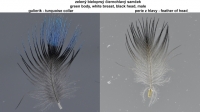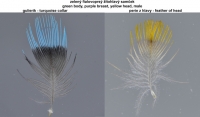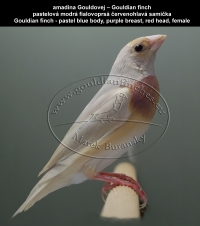Tweet



Tweet
marek buransky, 13.09.2012 20:02
sfarbenie hlav u amadin Gouldovej
Výber zo zahraničného fóra, kde bola zverejnená kapitola o sfarbení hlavy u amadín Gouldovej
Re: pigments in feathear of head gouldian finches by Tiaris on Yesterday, 14:06
Very interesting reading & thanks very much for posting. I am baffled that all of this theory can be based on the assumption that the different head colours previously existed as geographically isolated populations in the past when there is no evidence at all to support this. This assumption just conveniently suits the findings with regard to head colour is affect on temperament. If the assumption was correct it would be very reasonable to assume that the previous strong-hold region for the red-headed form would include a population dominated by red-headed birds given its dominant mode of inheritence, however I have only ever heard that the black-headeds are more common across all of Northern Australia, which in my opinion is clear cut evidence to refute the assumption of geographically isolated separate head colour populations.
Re: pigmenty v perí hlavy amadín Gouldovej od Tiaris Včera, 14:06
Veľmi zaujímavé čítanie a vďaka moc za zverejnenie. Som bezradný, že všetky tieto teórie môžu byť založené len na predpoklade, že rôzne sfarbenie hlavy skôr vzniklo v geograficky izolovaných populáciách v minulosti, na toto tvrdenie však nie je žiadny dôkaz. Tento predpoklad len pohodlne vyhovuje zisteniu, pokiaľ ide o sfarbenie hlavy a vplyv na temperament vtákov. Ak predpoklad bol správny, bolo by veľmi rozumné predpokladať, že teritórium pre červenohlavú podobu by zahŕňalo dominantnú populáciu červenohlavých vtákov rovnako ako aj dominantný spôsob dedičnosti. Aj keď som počul, že čiernohlavé sa častejšie vyskytujú po celej Severnej Austrálii, čo je podľa môjho názoru úplne zrejmý dôkaz na vyvrátenie predpokladu geograficky izolovaných samostatných populácií.
Re: pigmenty v perí hlavy amadín Gouldovej by vettepilot_6 on Yesterday, 14:19
Can not agree more...I still find it astounding people say RH gould is the dominate head colour when 70plus % in the wild is BH...if RH was dominate would not they be the most common?
Nemožno než súhlasiť ... Stále mi to ohromujúci ľudia hovoria, že červenohlavé amadiny Gouldovej majú dominantnú hlavu farbu, keď 70% v divočine je čiernohlavých vtákov ... ak červenohlavá bola dominantná, nevyskytovala by sa častejšie?
Greetings,
I am not sure, if I am an advocate of the separate populations theory, where the populations have evolved individually and later merged. In my opinion the red-headed form is the nominate, i.e. original form and the black and yellow-headed forms are true mutations, that evolved in nature.
My assumption is supported by the structure – the architecture of the plumage on the head. The re ‑headed form as well as the black and yellow-headed have a similar structure of the feathers of the turquoise collar below the head. The head feathers of the red and yellow-headed birds also have a similar structure. However the blacks feathers have a different shape, which points to mutation and this form in my opinion developed from the red-headed birds. In the yellow-headed birds only the red pigment creation has changed, the feather structure is the same as in the red-headed ones.
Why are there more black-headed birds in the wild? That may be attributed to the fact that black is less attractive for the natural predators than bright red or yellow heads. The black head gene is also sex linked so a single factor of black in the male will suffice for this mutation to emerge in the F1 generation, so if we mate a red-headed male with a single-factor for black with a red headed female there might be black headed females among the offspring. So when two phenotypically dominant-trait birds mate we end up with a mutated color black-headed bird. This way, black-headed females are introduced into the population, which if mate with black-headed, or single-factor red-headed males, will produce a significant number of black-headed offspring.
Marek Buransky
Zdravím.
Nie som si istý, čí aj ja som zástanca teórie oddelených populácii, ktoré sa vyvíjali samostatne a ktoré sa neskôr spojili. Podľa môjho názoru je však červenohlavá forma formou nominátnou, teda pôvodnou a čiernohlavá a žltohlavá forma sú pravými mutáciami, ktoré vznikli v prírode.
Tento môj predpoklad potvrdzuje aj štruktúra - architektúra operia na hlave. Červenohlavá forma ako, čiernohlavá a zltohlavá majú rovnakú štruktúru peria tyrkysového golierika za hlavou. Podobnú stavbu peria má aj perie na hlave u červenohlavých a žltohlavých vtákov. Perie u čiernohlavých však má zmenený tvar, čo svedčí o mutácii, teda táto forma podľa mňa vznikla z červenohlavých vtákov. U žltohlavých ide len o zmenu tvorby červeného farbiva, štruktúra peria je však totožná s červenohlavými vtákmi.
Prečo je v prírode viac čiernohlavých vtákov? Môže to mať za následok aj skutočnosť, že čierna hlava je menej aktaktívna pre prirodzených predátorov, než svietivo červená, či žltá hlava. Čiernohlavá je tiež viazaná na pohlavie a teda stačí jeden SF faktor čiernej u samčeka, aby sa táto mutácia prejavila už v generácii F1, teda ak spárime červenohlavého samčeka s SF faktorom pre čiernu a červenohlavú samičku, v potomstve budú aj čiernohlavé samičky. Teda opri párení oboch vtákov s dominantným znakom vo fenotype dostaneme mutačne sfarbeného čiernohlavého vtáka. V populácii takto vznikajú čiernohlavé samičky, ktoré ak sa spária s čiernohlavým samčekom, alebo červenohlavým s SF pre čiernu, potomstvo bude výrazne niesť čiernu farbu hlavy.
S pozdravom.
Marek Buransky
Re: pigments in feathear of head gouldian finches by Tiaris on Yesterday, 14:06
Very interesting reading & thanks very much for posting. I am baffled that all of this theory can be based on the assumption that the different head colours previously existed as geographically isolated populations in the past when there is no evidence at all to support this. This assumption just conveniently suits the findings with regard to head colour is affect on temperament. If the assumption was correct it would be very reasonable to assume that the previous strong-hold region for the red-headed form would include a population dominated by red-headed birds given its dominant mode of inheritence, however I have only ever heard that the black-headeds are more common across all of Northern Australia, which in my opinion is clear cut evidence to refute the assumption of geographically isolated separate head colour populations.
Re: pigmenty v perí hlavy amadín Gouldovej od Tiaris Včera, 14:06
Veľmi zaujímavé čítanie a vďaka moc za zverejnenie. Som bezradný, že všetky tieto teórie môžu byť založené len na predpoklade, že rôzne sfarbenie hlavy skôr vzniklo v geograficky izolovaných populáciách v minulosti, na toto tvrdenie však nie je žiadny dôkaz. Tento predpoklad len pohodlne vyhovuje zisteniu, pokiaľ ide o sfarbenie hlavy a vplyv na temperament vtákov. Ak predpoklad bol správny, bolo by veľmi rozumné predpokladať, že teritórium pre červenohlavú podobu by zahŕňalo dominantnú populáciu červenohlavých vtákov rovnako ako aj dominantný spôsob dedičnosti. Aj keď som počul, že čiernohlavé sa častejšie vyskytujú po celej Severnej Austrálii, čo je podľa môjho názoru úplne zrejmý dôkaz na vyvrátenie predpokladu geograficky izolovaných samostatných populácií.
Re: pigmenty v perí hlavy amadín Gouldovej by vettepilot_6 on Yesterday, 14:19
Can not agree more...I still find it astounding people say RH gould is the dominate head colour when 70plus % in the wild is BH...if RH was dominate would not they be the most common?
Nemožno než súhlasiť ... Stále mi to ohromujúci ľudia hovoria, že červenohlavé amadiny Gouldovej majú dominantnú hlavu farbu, keď 70% v divočine je čiernohlavých vtákov ... ak červenohlavá bola dominantná, nevyskytovala by sa častejšie?
Greetings,
I am not sure, if I am an advocate of the separate populations theory, where the populations have evolved individually and later merged. In my opinion the red-headed form is the nominate, i.e. original form and the black and yellow-headed forms are true mutations, that evolved in nature.
My assumption is supported by the structure – the architecture of the plumage on the head. The re ‑headed form as well as the black and yellow-headed have a similar structure of the feathers of the turquoise collar below the head. The head feathers of the red and yellow-headed birds also have a similar structure. However the blacks feathers have a different shape, which points to mutation and this form in my opinion developed from the red-headed birds. In the yellow-headed birds only the red pigment creation has changed, the feather structure is the same as in the red-headed ones.
Why are there more black-headed birds in the wild? That may be attributed to the fact that black is less attractive for the natural predators than bright red or yellow heads. The black head gene is also sex linked so a single factor of black in the male will suffice for this mutation to emerge in the F1 generation, so if we mate a red-headed male with a single-factor for black with a red headed female there might be black headed females among the offspring. So when two phenotypically dominant-trait birds mate we end up with a mutated color black-headed bird. This way, black-headed females are introduced into the population, which if mate with black-headed, or single-factor red-headed males, will produce a significant number of black-headed offspring.
Marek Buransky
Zdravím.
Nie som si istý, čí aj ja som zástanca teórie oddelených populácii, ktoré sa vyvíjali samostatne a ktoré sa neskôr spojili. Podľa môjho názoru je však červenohlavá forma formou nominátnou, teda pôvodnou a čiernohlavá a žltohlavá forma sú pravými mutáciami, ktoré vznikli v prírode.
Tento môj predpoklad potvrdzuje aj štruktúra - architektúra operia na hlave. Červenohlavá forma ako, čiernohlavá a zltohlavá majú rovnakú štruktúru peria tyrkysového golierika za hlavou. Podobnú stavbu peria má aj perie na hlave u červenohlavých a žltohlavých vtákov. Perie u čiernohlavých však má zmenený tvar, čo svedčí o mutácii, teda táto forma podľa mňa vznikla z červenohlavých vtákov. U žltohlavých ide len o zmenu tvorby červeného farbiva, štruktúra peria je však totožná s červenohlavými vtákmi.
Prečo je v prírode viac čiernohlavých vtákov? Môže to mať za následok aj skutočnosť, že čierna hlava je menej aktaktívna pre prirodzených predátorov, než svietivo červená, či žltá hlava. Čiernohlavá je tiež viazaná na pohlavie a teda stačí jeden SF faktor čiernej u samčeka, aby sa táto mutácia prejavila už v generácii F1, teda ak spárime červenohlavého samčeka s SF faktorom pre čiernu a červenohlavú samičku, v potomstve budú aj čiernohlavé samičky. Teda opri párení oboch vtákov s dominantným znakom vo fenotype dostaneme mutačne sfarbeného čiernohlavého vtáka. V populácii takto vznikajú čiernohlavé samičky, ktoré ak sa spária s čiernohlavým samčekom, alebo červenohlavým s SF pre čiernu, potomstvo bude výrazne niesť čiernu farbu hlavy.
S pozdravom.
Marek Buransky



Pre vloženie nového príspevku musíte byť prihlásený.
marek buransky, 13.09.2012 20:05
Greetings.
As I have noted previously, I think the red head coloring is the nominate – original form of Gouldian Finch head coloring. According to my findings it is also genetically hereditary dominant coloring.
In my last post I stated the reason for this is plumage morphology, where the collar feathers are the same in all three head colorings. Changes only occur in the black-headed form directly in the morphology of head feathers. The feathers are different in structure from the head feathers of red and yellow-headed birds, as well as from the turquoise collar feathers. It is necessary to consider the fact that the collar feathers are the same in all three kinds.
If we were to accept that the original – nominate form is the black-headed one and red and yellow -headed are its mutations, then it seems strange and improbable that the head feathers would mutate into the same form as the collar feathers. I find the structure of the collar feathers important in supporting the theory that not the black-headed form mutated into red and yellow-headed forms, but that the original form was the red-headed one.
Genetic heredity and dominance according to Mendels laws of genetics is one thing but the ability of the dominant trait-bearing specimens to survive and „dominate“ the population is a different thing entirely. There is no direct proportion between the two.
I have already mentioned natural predators and as was proven by studies, the red-headed birds are more susceptible to stress and resulting diseases that “decimate” their population. All of this might be the reason why the recessive black-headed form is more common in the wild, this trait is also sex-linked and spreads easily in the population. It would also seem that the black-headed birds undergo less stress and have higher resistance to disease.
Kind regards.
Marek Buransky
Zdravím.
Ako som už uviedol, pokladám červenú farbu hlavy za nominátnu, teda prvotnú – pôvodnú formu sfarbenia u amadín Gouldovej. Tiež je to podľa mojich zistení geneticky dedične dominantná farba.
Už v minulom príspevku som to zdôvodnil morfológiou peria, kde perie golierika je u všetkých troch typov sfarbenia hlavy rovnaké. Zmena nastáva len u čiernohlavej formy, a to priamo v morfológii peria hlavy. Toto perie je svojou štruktúrou odlišné od peria hlavy červeno a žltohlavých vtákov, ako aj od štruktúry peria z tyrkysového golierika. Je potrebné brať do úvahy, že tvar peria na tyrkysovom golieriku je u všetkých rovnaký.
Ak by som pripustil, že nominátna- pôvodná forma je čiernohlavá a červeno a žltohlavé sú jej mutáciami, tak by bolo dosť zvláštne a nepravdepodobné, že by zmutovali práve do podoby peria na golieriku. Práve tvar peria z tyrkysového golierika pokladám za dôležitý pre obhájenie teórie, že neprišlo k mutácii čiernohlavej formy na červenohlavú, či žltohlavú, ale že pôvodná forma bola červenohlavá.
Genetická dedičnosť, teda dominancia podľa Mendelových zákonov genetiky je jedna vec ale schopnosť jedincov nesúcich dominantný znak prežiť a „dominovať“ v populácii je už vecou odlišnou. Nie je tu priama úmera medzi týmito faktami.
Už som tu spomenul prirodzených predátorov, a tiež ako dokazujú štúdie, červenohlavé vtáky viac podliehajú stresu a teda aj prípadným chorobám, ktoré ich „decimujú“. Toto všetko má za následok, že sa v prírode viac presadila geneticky recesívna čierna farba hlavy, ktorá je navyše viazaná na pohlavie a teda sa ľahko šíri v populácii. Navyše sa zdá, že čiernohlavé vtáky sú menej stresovatelné a teda že aj majú vyššiu odolnosť voči chorobám.
Zdravim.
Marek Buransky
As I have noted previously, I think the red head coloring is the nominate – original form of Gouldian Finch head coloring. According to my findings it is also genetically hereditary dominant coloring.
In my last post I stated the reason for this is plumage morphology, where the collar feathers are the same in all three head colorings. Changes only occur in the black-headed form directly in the morphology of head feathers. The feathers are different in structure from the head feathers of red and yellow-headed birds, as well as from the turquoise collar feathers. It is necessary to consider the fact that the collar feathers are the same in all three kinds.
If we were to accept that the original – nominate form is the black-headed one and red and yellow -headed are its mutations, then it seems strange and improbable that the head feathers would mutate into the same form as the collar feathers. I find the structure of the collar feathers important in supporting the theory that not the black-headed form mutated into red and yellow-headed forms, but that the original form was the red-headed one.
Genetic heredity and dominance according to Mendels laws of genetics is one thing but the ability of the dominant trait-bearing specimens to survive and „dominate“ the population is a different thing entirely. There is no direct proportion between the two.
I have already mentioned natural predators and as was proven by studies, the red-headed birds are more susceptible to stress and resulting diseases that “decimate” their population. All of this might be the reason why the recessive black-headed form is more common in the wild, this trait is also sex-linked and spreads easily in the population. It would also seem that the black-headed birds undergo less stress and have higher resistance to disease.
Kind regards.
Marek Buransky
Zdravím.
Ako som už uviedol, pokladám červenú farbu hlavy za nominátnu, teda prvotnú – pôvodnú formu sfarbenia u amadín Gouldovej. Tiež je to podľa mojich zistení geneticky dedične dominantná farba.
Už v minulom príspevku som to zdôvodnil morfológiou peria, kde perie golierika je u všetkých troch typov sfarbenia hlavy rovnaké. Zmena nastáva len u čiernohlavej formy, a to priamo v morfológii peria hlavy. Toto perie je svojou štruktúrou odlišné od peria hlavy červeno a žltohlavých vtákov, ako aj od štruktúry peria z tyrkysového golierika. Je potrebné brať do úvahy, že tvar peria na tyrkysovom golieriku je u všetkých rovnaký.
Ak by som pripustil, že nominátna- pôvodná forma je čiernohlavá a červeno a žltohlavé sú jej mutáciami, tak by bolo dosť zvláštne a nepravdepodobné, že by zmutovali práve do podoby peria na golieriku. Práve tvar peria z tyrkysového golierika pokladám za dôležitý pre obhájenie teórie, že neprišlo k mutácii čiernohlavej formy na červenohlavú, či žltohlavú, ale že pôvodná forma bola červenohlavá.
Genetická dedičnosť, teda dominancia podľa Mendelových zákonov genetiky je jedna vec ale schopnosť jedincov nesúcich dominantný znak prežiť a „dominovať“ v populácii je už vecou odlišnou. Nie je tu priama úmera medzi týmito faktami.
Už som tu spomenul prirodzených predátorov, a tiež ako dokazujú štúdie, červenohlavé vtáky viac podliehajú stresu a teda aj prípadným chorobám, ktoré ich „decimujú“. Toto všetko má za následok, že sa v prírode viac presadila geneticky recesívna čierna farba hlavy, ktorá je navyše viazaná na pohlavie a teda sa ľahko šíri v populácii. Navyše sa zdá, že čiernohlavé vtáky sú menej stresovatelné a teda že aj majú vyššiu odolnosť voči chorobám.
Zdravim.
Marek Buransky
Pre vloženie nového príspevku musíte byť prihlásený.
Odoberanie vajíčok a ich následná inkubácia
02.11.2016 - Kniha o chove amadín Gouldovej.
http://savethegouldian.net/
http://gfinches2.com/
http://www.gouldamadine.de/
http://www.novaexota.eu/
http://www.epapousek.cz/

http://gfinches2.com/
http://www.gouldamadine.de/
http://www.novaexota.eu/
http://www.epapousek.cz/

Texty a fotografie nie je možné šíriť bez súhlasu autora
stránok www.gouldianfinchces.eu
stránok www.gouldianfinchces.eu
Kontakt:







